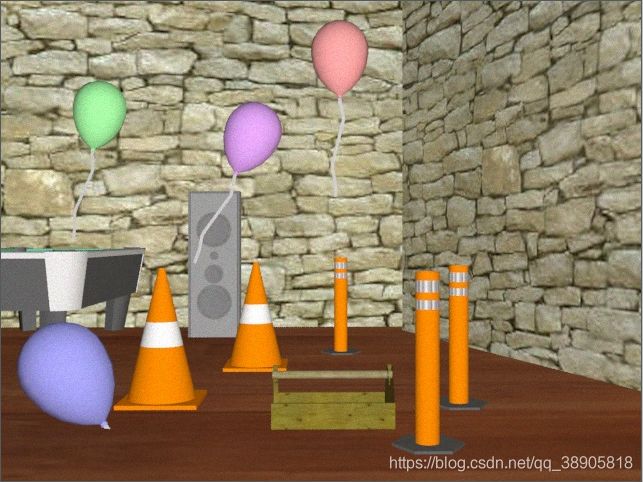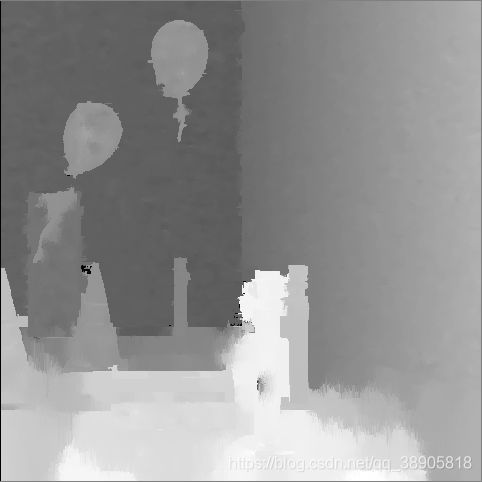由一对立体图像组(Stereo image pairs)生成Disparity Map和Epipolar Line
input:
Disparity Map
import numpy as np
import cv2
#pip3 install -i https://pypi.tuna.tsinghua.edu.cn/simple opencv-contrib-python
print('loading images...')
imgL = cv2.imread('data_PG/relative_height/1_a.jpg') # downscale images for faster processing
imgR = cv2.imread('data_PG/relative_height/1_b.jpg')
# SGBM Parameters -----------------
window_size = 3 # wsize default 3; 5; 7 for SGBM reduced size image; 15 for SGBM full size image (1300px and above); 5 Works nicely
left_matcher = cv2.StereoSGBM_create(
minDisparity=0,
numDisparities=160, # max_disp has to be dividable by 16 f. E. HH 192, 256
blockSize=5,
P1=8 * 3 * window_size ** 2, # wsize default 3; 5; 7 for SGBM reduced size image; 15 for SGBM full size image (1300px and above); 5 Works nicely
P2=32 * 3 * window_size ** 2,
disp12MaxDiff=1,
uniquenessRatio=15,
speckleWindowSize=0,
speckleRange=2,
preFilterCap=63,
mode=cv2.STEREO_SGBM_MODE_SGBM_3WAY
)
right_matcher = cv2.ximgproc.createRightMatcher(left_matcher)
# FILTER Parameters
lmbda = 80000
sigma = 1.2
visual_multiplier = 1.0
wls_filter = cv2.ximgproc.createDisparityWLSFilter(matcher_left=left_matcher)
wls_filter.setLambda(lmbda)
wls_filter.setSigmaColor(sigma)
print('computing disparity...')
displ = left_matcher.compute(imgL, imgR) # .astype(np.float32)/16
dispr = right_matcher.compute(imgR, imgL) # .astype(np.float32)/16
displ = np.int16(displ)
dispr = np.int16(dispr)
filteredImg = wls_filter.filter(displ, imgL, None, dispr) # important to put "imgL" here!!!
filteredImg = cv2.normalize(src=filteredImg, dst=filteredImg, beta=0, alpha=255, norm_type=cv2.NORM_MINMAX);
filteredImg = np.uint8(filteredImg)
cv2.imshow('Disparity Map', filteredImg)
cv2.waitKey()
cv2.destroyAllWindows()output:
Epipolar Geometry
# encoding=gbk
import cv2
import numpy as np
import cv2 as cv
import random
from matplotlib import pyplot as plt
#pip3 install -i https://pypi.tuna.tsinghua.edu.cn/simple opencv-contrib-python==3.3.0.10
img1 = cv2.imread('data_PG/relative_height/1_a.jpg',0) #queryimage # left image
img2 = cv2.imread('data_PG/relative_height/1_b.jpg',0) #trainimage # right image
#sift = cv2.SIFT()
sift = cv2.xfeatures2d.SIFT_create() #opencv将SIFT等算法整合到xfeatures2d集合里面了
# find the keypoints and descriptors with SIFT
kp1, des1 = sift.detectAndCompute(img1,None)
kp2, des2 = sift.detectAndCompute(img2,None)
# FLANN parameters
FLANN_INDEX_KDTREE = 1
index_params = dict(algorithm = FLANN_INDEX_KDTREE, trees = 5)
search_params = dict(checks=50)
flann = cv2.FlannBasedMatcher(index_params,search_params)
matches = flann.knnMatch(des1,des2,k=2)
good = []
pts1 = []
pts2 = []
# ratio test as per Lowe's paper
for i,(m,n) in enumerate(matches):
if m.distance < 0.8*n.distance:
if random.randint(1,100) == 100:
good.append(m)
pts2.append(kp2[m.trainIdx].pt)
pts1.append(kp1[m.queryIdx].pt)
pts1 = np.int32(pts1)
pts2 = np.int32(pts2)
F, mask = cv2.findFundamentalMat(pts1,pts2,cv.FM_LMEDS)
# We select only inlier points
pts1 = pts1[mask.ravel()==1]
pts2 = pts2[mask.ravel()==1]
def drawlines(img1,img2,lines,pts1,pts2):
''' img1 - image on which we draw the epilines for the points in img2
lines - corresponding epilines '''
r,c = img1.shape
img1 = cv2.cvtColor(img1,cv2.COLOR_GRAY2BGR)
img2 = cv2.cvtColor(img2,cv2.COLOR_GRAY2BGR)
count = 0
for r,pt1,pt2 in zip(lines,pts1,pts2):
count = count + 1
color = tuple(np.random.randint(0,255,3).tolist())
x0,y0 = map(int, [0, -r[2]/r[1] ])
x1,y1 = map(int, [c, -(r[2]+r[0]*c)/r[1] ])
img1 = cv2.line(img1, (x0,y0), (x1,y1), color,1)
img1 = cv2.circle(img1,tuple(pt1),5,color,-1)
img2 = cv2.circle(img2,tuple(pt2),5,color,-1)
if count == 4:
break
return img1,img2
# Find epilines corresponding to points in right image (second image) and
# drawing its lines on left image
lines1 = cv2.computeCorrespondEpilines(pts2.reshape(-1,1,2), 2,F)
lines1 = lines1.reshape(-1,3)
img5,img6 = drawlines(img1,img2,lines1,pts1,pts2)
# Find epilines corresponding to points in left image (first image) and
# drawing its lines on right image
lines2 = cv2.computeCorrespondEpilines(pts1.reshape(-1,1,2), 1,F)
lines2 = lines2.reshape(-1,3)
img3,img4 = drawlines(img2,img1,lines2,pts2,pts1)
plt.subplot(121),plt.imshow(img5)
plt.subplot(122),plt.imshow(img3)
plt.show()output:


